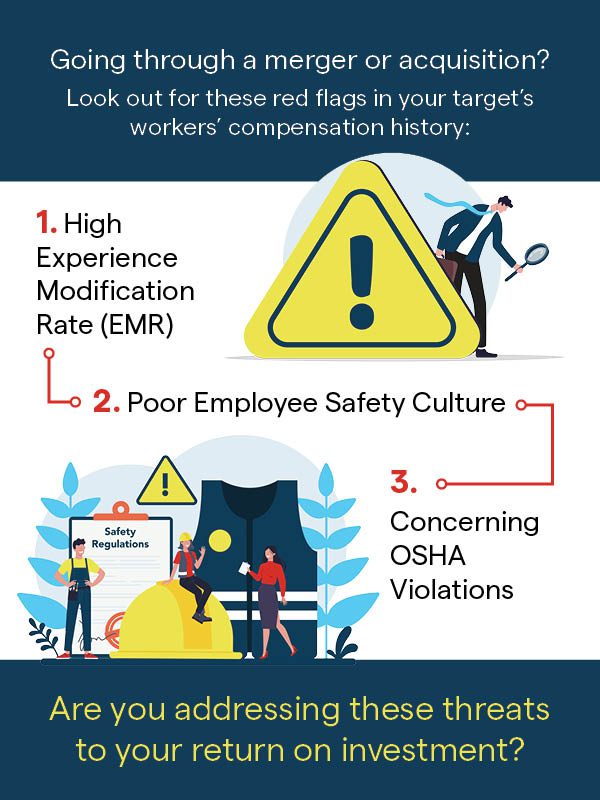During a merger or acquisition, disregarding a target’s workers’ compensation history can be one of the biggest threats to the success of a transaction. If a company has a risky history, the buyer could face high insurance premium costs in the near future – an expensive mistake that could easily be avoided with proper due diligence.
Focusing on workers’ compensation is critical to ensuring the success of an investment. Here are the top three areas to evaluate.

Top 3 Red Flags When Evaluating Workers’ Compensation History
Area #1: High Experience Modification Rate
An Experience Modification Rate (EMR) predicts a company’s future risk of loss based on past losses and several other factors over the past three full years (not including the current term). It is then compared to other peers in the state to determine a company’s specific rating.
A rate of 1.0 means that a target is average compared to its peers. A rate lower or higher than 1.0 can mean it is better or worse than its peers. Rates can drop well below 1.0 and increase to over 2.0 depending on the frequency and severity of a target’s workers’ compensation losses.
There are two reasons the EMR is important. First, it calculates a company’s workers’ compensation premium. For instance, if a target is currently paying $500,000 in premiums based on a .70 EMR, that could signify a well-performing workers’ compensation program with low losses.
However, the EMR only rewards the company for the success it has had in the past. The company’s performance during the current term may lead the post-close EMR to increase. There are both quantitative and qualitative factors that should be argued by the broker to push for offsetting credits and a lower cost. But the threat of a much higher premium that impacts the post-close Profit & Loss statement is undeniable.
Second, the EMR is often used as a benchmark by companies’ clients to determine if they want to continue doing business with them. This is common in the construction industry and for any firms working with municipal, utility or government entities.
Typically, a customer will require that a vendor’s EMR remain at 1.0 or lower. If it goes higher, they may put them on a probationary period or ask for justification to continue doing business with them. They can also simply remove the vendor altogether, leaving the target without one of its largest clients. We referenced this scenario in 5 Ways to Kill a Private Equity Deal, which is by far one of the worst scenarios an investor can find themselves in post-close.
To prevent both issues, the buyer must use an insurance professional to analyze the necessary data to determine what the future EMR will be post-close, both on the immediate renewal and with projections for future EMRs. A third-party safety consulting firm should be hired to engage with the operators and implement a continuous process of improvement aimed at preventing and mitigating losses. The only way to ensure workers’ compensation success is by investing in safety and making it a part of the company culture.
Area #2: Poor Employee Safety Culture
For numbers-driven professionals in areas such as finance and insurance, employee culture can be an afterthought. But we’ve found certain activities that drive a positive employee safety culture can be the best leading indicators of success for improving EMRs and costs in general.
At Horton, we believe in the safety pyramid. This is a concept where certain activities lead employees to take positive safety actions when presented with options. Summarized at a high level, a company needs to prevent employees from making unsafe behaviors, which can eventually lead to large claims. A culture where employees feel they can routinely make unsafe decisions, inevitably leads to a company with workers compensation issues.
For this reason, reviewing several sets of data during the due diligence process is critical. This includes workers’ compensation loss runs, OSHA violation searches (as referenced below), OSHA 300 logs, and, if possible, hiring a third-party safety consulting firm to view the operations with you.
Area #3: Concerning OSHA Violations
One commonly overlooked area associated with workers’ compensation is OSHA violations. This information can be obtained easily on the Department of Labor’s OSHA search page. Here you can look by the target’s name to determine whether they have any violations, the type of violations, codes associated with those violations that give indications of what took place, and the fines associated with the violations.
This critical information gives insight into the operations and whether they are performing well and provides necessary attention to safety regulations and cultural issues.
A target having OSHA violations doesn’t mean you shouldn’t proceed with the transaction. But a discussion surrounding these violations should be had with the sellers, and immediate attention to these facilities needs to occur post-close.
We recommend hiring a third-party safety consultant to perform site assessments and conducting a Mock OSHA Audit to ensure these violations are not an issue. These audits often help operations improve their safety culture and address future issues. On a recent diligence project, the Horton team discovered that an EMR was artificially inflated due to the missing policy term of loss information on the Experience Mod Worksheet. After filing the missing loss information with the Workers’ Compensation Bureau, the EMR was reduced by 0.12, which resulted in a 14% reduction in premium. For an employer paying $400K in annual Workers’ Compensation premium, that savings would amount to $56K annually.
Don’t Let Workers’ Compensation History Blindside You
Proper due diligence in all areas of the business you are acquiring will offer you peace of mind when it comes to your next deal. Horton’s M&A team is here to navigate the due diligence process, evaluate your past workers’ compensation history and ensure that you are prepared for any risks that lie ahead.
Material posted on this website is for informational purposes only and does not constitute a legal opinion or medical advice. Contact your legal representative or medical professional for information specific to your legal or medical needs.





